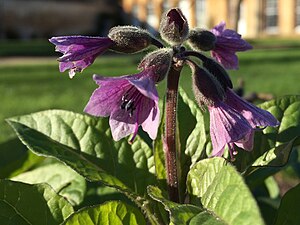Physochlaina
| Physochlaina | ||||||||||||
|---|---|---|---|---|---|---|---|---|---|---|---|---|

|
||||||||||||
| Systematics | ||||||||||||
|
||||||||||||
| Scientific name | ||||||||||||
| Physochlaina | ||||||||||||
| G.Don |

Physochlaina is a plant genus of the family of the nightshade family (Solanaceae). It consists of eight to eleven species that are common in Asia .
description
Vegetative characteristics
Physochlaina species are perennial, herbaceous plants with robust, fleshy, tuberous roots . The stems are erect or ascending and reach heights of 0.3 to 0.7 (rarely 0.1 to 1) m. They are branched, angled and hairy with simple or single- or multicellular heads, glandular trichomes . The leaves have petioles 1 to 8 cm long . The leaf blades are 4 to 22 cm long and 2 to 12 cm wide, their shape is egg-shaped-elliptical, triangular or egg-shaped triangular. The leaf margin can be entire, wavy or have a few irregular teeth.
Inflorescences and flowers
The panicle-shaped inflorescences are terminal or axillary. They consist of three to fourteen flowers , which are accompanied by scaly or foliage-like bracts . The flowers are almost sessile or stand on 2 to 20 mm long peduncles. The calyx is radial symmetry and bell-shaped, tubular-bell-shaped or tubular-urn-shaped. It becomes 6 to 11 (rarely also up to 15) mm long and is occupied with five triangular, mostly identically shaped calyx lobes, which reach a third to a quarter (rarely half) the length of the calyx tube. The crown is radially symmetrical, 15 to 30 mm long and consists of a basal, tubular section that widens towards the top and is covered with triangular to broadly ovate corolla lobes that reach a quarter to a fifth of the length of the corolla tube. The color of the crown can be purple, purple or yellow with purple veins.
The stamens can stand over the crown or be surrounded by it. The stamens are significantly longer than the anthers. The starting point of the stamens is in the middle of the corolla tube, the anthers are fixed dorsally (on the back) to the stamens and reach a length of 1.9 to 2.6 (rarely only 1.5) mm. The pollen grains are medium-sized with a size of 35 to 36 µm, their shape is almost spherical, they are pentacolporate or often also tetracolporate. The scar is disc-shaped. A protruding, ring-shaped nectarium is formed.
Fruits and seeds
The fruits are almost spherical or elongated pyxidia , lid capsules, which are hidden in a greatly enlarged, inflated calyx with pointed tips enlarged to 15 to 20 (rarely up to 23) mm. The seeds are 2.2 to 2.8 mm long and 1.2 to 2.5 mm wide. Their shape is either egg-shaped, spherical or elliptical, they can be indented, only slightly indented or pronouncedly indented. The relatively large hilum is arranged at the base and protrudes to strongly protruding. The surface of the seeds is mostly reticulated, occasionally brain-shaped and reticulated only near the hilum. The embryo is almost helical, the endosperm is abundantly developed.
Other features
The alkaloid Physochlain has so far only been found in species of the genus Physochlaina ; they also contain hyoscyamine , scopolamine and cuscohygrin, among others . Karyological studies on two species resulted in a base chromosome number of x = 14.
Distribution and locations
The species of the genus Physochlaina are widespread in Asia and occur there in valleys and mountain forests at altitudes between 800 and 4500 m.
Systematics
External system
Within the nightshade family (Solanaceae), the genus is classified in the Hyoscyaminae, which were initially listed as a subtribe and later as a tribe. Both the morphologically based systematics by Armando Hunziker and the molecular-biological systematics by Richard Olmstead classify the tribes in the subfamily Solanoideae. In addition to Physochlaina, Olmstead counts the genera Anisodus , Archihyoscyamus , Atropa , Atropanthe , Hyoscyamus Przewalskia and Scopolia in the tribe, Hunziker assigns the genus Atropa to an independent tribe Atropeae, Archihyoscyamus as a synonym of Hyoscyamus .
Internal system
Depending on the author, the number of species in modern adaptations is given as eight or eleven. According to Hunziker, the following species belong to the genus:
- Physochlaina capitata A.M.Lu
- Physochlaina infundibularis Kuang
- Physochlaina macrocalyx Pascher
- Physochlaina macrophylla Bonati
- Physochlaina orientalis G. Don
- Physochlaina physaloides (L.) G. Don
- Physochlaina praealta (Decne.) Miers
- Physochlaina semenowi rule
The type species is Physochlaina physaloides .
The generic name is derived from the Greek , physa means bladder and chlaina means an outer shell.
proof
literature
- Armando T. Hunziker: The Genera of Solanaceae . ARG Gantner Verlag KG, Ruggell, Liechtenstein 2001. ISBN 3-904144-77-4 .
Individual evidence
- ↑ a b c d Armando T. Hunziker: The Genera of Solanaceae . ARG Gantner Verlag KG, Ruggell, Liechtenstein 2001. ISBN 3-904144-77-4 .
- ↑ a b Zhi-Yun Zhang, Dong-Zhi Yang, An-Ming Lu and Sandra Knapp: Seed morphology of the tribe Hyoscyameae (Solanaceae) . In: Taxon , Volume 54, Number 1, February 2005. pp. 71-83.
- ^ A b Richard G. Olmstead and Lynn Bohs: A Summary of Molecular Systematic Research in Solanaceae: 1982-2006 . In: DM Spooner et al. (Ed.): Solanaceae VI: Genomics Meets Biodiversity , ISHS Acta Horticulturae 745, June 2007. pp. 255-268. ISBN 978-90-6605-427-1 .
- ^ MN Semenova: Physochlaina . In: BK Schischkin and EG Bobrov (eds.): Flora of the USSR: Solanaceae and Scrophulariaceae, Translated from Russian , Volume 22, Smithsonian Institution Libraries, Washington DC, USA, 1997. pp. 90-94.